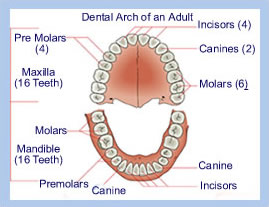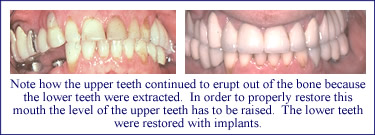
If your house has a solid foundation, it can easily be preserved by fixing the walls or by changing the wallpaper. If it has a poor foundation, however, no amount of wallpaper will save it. The same is true in the mouth. The amount of bone surrounding the teeth and the shape and length of the roots is the foundation for the mouth. When the bone disappears, there is less support for the teeth. If all the bone disappears around the teeth, abcesses occur and the teeth are lost. This process—often painless—is called periodontal disease. One of the main reasons for taking X-Rays is to examine the soundness of this foundation below the gums. We take a full series of X-Rays every two years to ensure that we don’t miss any changes in the bone that might have occurred.
Uncontrollable Causes of Tooth Loss
- Genetics
- Systemic Conditions (e.g. heart disease, cancer, and diabetes.)
- Poor Root Formation
Factors causing bone loss that can be controlled or eliminated
- Plaque and Calculus Build-up
- Decay
- Food Impaction Area
- Destructive Habits
- Missing Teeth
- Abnormal Bite
- Abnormal Growth and Development
- Smoking
Because we do not know how to grow the bone back once it is lost, Prevention is the key to preserving oral health. The goal of most dental treatment is eliminate or minimize the factors known to contribute to bone loss:
- Regular oral hygiene visits are an important strategy in maintaining oral health for two reasons. First, elimination of plaque and calculus greatly reduces the risk of periodontal bone loss by reducing inflammation in the overlying gum tissues. Healthy gum tissues also prevent bacteria in the mouth from easily entering the blood stream. Second, regular examinations often allow minor problems to be corrected before they become major ones. Regular hygiene is by far the best way to prevent future trouble.
- Dental Treatment corrects problems that will ultimately contribute to bone loss in most people.Dentistry that is designed according to basic engineering principles has a far greater chance of lasting in health. A high percentage of success can be obtained from minimizing and balancing forces applied to the supporting structures. Properly designed dental restorations can greatly reduce most of the risk factors for periodontal disease and tooth loss listed above. In designing restorations for those with risk factors which Dentistry cannot control—i.e. genetic and systemic conditions—it is prudent to design restorations with a contingency plan in the event that something does go wrong. Restorative Dentistry can prevent or mitigate loss of teeth in patients susceptible to periodontal disease in spite of systemic diseases such as cancer, heart disease and diabetes.
- Quit Smoking. Smokers are more likely than nonsmokers to accumulate calculus, develop deep pockets between the gums and teeth and have periodontal bone loss. All tobacco products can lead to the following:
Oral Cancer
Bad Breath
Stained Teeth
Tooth Loss
Bone Loss
Loss of Taste
Gum Recession
Mouth Sores
Facial wrinkling
Less Success with Periodontal Treatment
Less Success with Dental Implants
For more information about the dangers of smoking to oral health, visit the website of the American Academy of Periodontology (www.perio.org)
Why it is important to replace missing Teeth:
 When a tooth is missing, the teeth around the space drift and tilt into the space—just as removing the middle book from 3 books on a shelf will result in the collapse of the two end books. The teeth opposite the space will tend to erupt into the space. When teeth are in an abnormal position, they absorb forces in abnormal directions. No one knows at what point the body will not be able to tolerate these forces. When the body’s resistance to abnormal forces breaks down the result is almost always periodontal bone loss—in both upper and lower arches. When all the bone around the roots of teeth disappears, abcesses and loss of teeth occur. The theory of Oral Dynamics attributes this type of bone loss to interruption of blood supply in the area: “Masticatory [chewing] blows upon a tooth do affect its blood supply for good or ill. It can be shown that if the force is directed for absorption through lines paralleling the long axis of the tooth, the tooth will receive a full blood supply. It can be shown also that if the force is not directed along lines roughly paralleling the long axis, the tooth will receive a reduced blood supply at best, with potentially serious consequences to the entire mastication apparatus [teeth, roots and bone]”. [The Principles and Practice of Oral Dynamics, by Thomas Forde].
When a tooth is missing, the teeth around the space drift and tilt into the space—just as removing the middle book from 3 books on a shelf will result in the collapse of the two end books. The teeth opposite the space will tend to erupt into the space. When teeth are in an abnormal position, they absorb forces in abnormal directions. No one knows at what point the body will not be able to tolerate these forces. When the body’s resistance to abnormal forces breaks down the result is almost always periodontal bone loss—in both upper and lower arches. When all the bone around the roots of teeth disappears, abcesses and loss of teeth occur. The theory of Oral Dynamics attributes this type of bone loss to interruption of blood supply in the area: “Masticatory [chewing] blows upon a tooth do affect its blood supply for good or ill. It can be shown that if the force is directed for absorption through lines paralleling the long axis of the tooth, the tooth will receive a full blood supply. It can be shown also that if the force is not directed along lines roughly paralleling the long axis, the tooth will receive a reduced blood supply at best, with potentially serious consequences to the entire mastication apparatus [teeth, roots and bone]”. [The Principles and Practice of Oral Dynamics, by Thomas Forde].
All Engineering Structures- including those on teeth and Implants will fail if overloaded.
The collapse of the Tacoma Narrows Bridge is one of the most famous engineering failures of all times. The builder’s failed to take into account the forces of the wind subjected to it. It lasted 5 months in 1940 before collapsing into the river-a $6.4 million total loss.
Ideal Engineering for Dentistry
- Brings the load closer to the supporting structures
- Reduces the load on the supporting structures
- Distributes the load evenly on the supporting structures
- Eliminates abnormal vectors of force on the suporting structures
- Promotes health and cleansability
